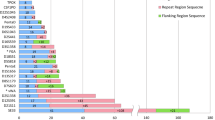Abstract
Short tandem repeats (STRs) are repetitive DNA sequences that are highly polymorphic and widely used for personal identification in the field of forensic medicine. The standard method for determining the repeat number of STRs is capillary electrophoresis of PCR products; however, the use of DNA sequencing has increased because it can identify same-sized alleles with nucleotide substitutions (iso-alleles). In this study, we performed human STR genotyping using a portable nanopore-based DNA sequencer, the MinION, and evaluated its performance. Because the sequence quality obtained by MinION is considerably lower than those obtained with other DNA sequencers, we developed an original scoring scheme for judging the genotypes from MinION reads. Analysis of seven human samples for 21–45 STR loci yielded an average of 857 thousand reads per sample, and the accuracy of genotyping and iso-allele identification reached 75.7% and 82%, respectively. Although the accuracy is higher than that reported previously, further improvements are required before this method can be practically applied.
This is a preview of subscription content, access via your institution
Access options
Subscribe to this journal
Receive 12 print issues and online access
$259.00 per year
only $21.58 per issue
Buy this article
- Purchase on Springer Link
- Instant access to full article PDF
Prices may be subject to local taxes which are calculated during checkout

Similar content being viewed by others
References
Woerner AE, King JL, Budowle B. Fast STR allele identification with STRait Razor 3.0. Forensic Sci Int Genet. 2017;30:18–23.
Jain M, Olsen HE, Paten B, Akeson M. The Oxford Nanopore MinION: delivery of nanopore sequencing to the genomics community. Genome Biol. 2016;17:239. 25
Jain M, Koren S, Miga KH, Quick J, Rand AC, Sasani TA, et al. Nanopore sequencing and assembly of a human genome with ultra-long reads. Nat Biotechnol. 2018;36:338–45.
Kim EH, Jung SE, Shin KJ, Yang WI, Yang IS. Sequence generation and genotyping of 15 autosomal STR markers using next generation sequencing. Korean J Leg Med. 2014;38:48–58.
Churchill JD, Schmedes SE, King JL2, Budowle B. Evaluation of the Illumina (®) Beta Version ForenSeq™ DNA Signature Prep Kit for use in genetic profiling. Forensic Sci Int Genet. 2016;20:20–29.
Guo F, Zhou Y, Liu F, Yu J, Song H, Shen H, et al. Evaluation of the early access STR Kit v1 on the Ion Torrent PGM™ platform. Forensic Sci Int Genet. 2016;23:111–20.
Zeng X, King JL, Stoljarova M, Warshauer DH, LaRue BL, Sajantila A, et al. High sensitivity multiplex short tandem repeat loci analyses with massively parallel sequencing. Forensic Sci Int Genet. 2015;16:38–47.
Cornelis S, Willems S, Van Neste C, Tytgat O, Weymaere J, Vander Plaetsen AS et al. Forensic STR profiling using Oxford Nanopore Technologies’ MinION sequencer. bioRxiv. 2018; https://doi.org/10.1101/433151.
Horai S, Murayama K, Hayasaka K, Matsubayashi S, Hattori Y, Fucharoen G, et al. mtDNA polymorphism in East Asian Populations, with special reference to the peopling of Japan. Am J Hum Genet. 1996;59:579–90.
van der Gaag KJ, de Leeuw RH, Hoogenboom J, Patel J, Storts DR, Laros JFJ, et al. Massively parallel sequencing of short tandem repeats-population data and mixture analysis results for the PowerSeq™ system. Forensic Sci Int Genet. 2016;24:86–96.
Smith TF, Waterman MS. Identification of common molecular subsequences. J Mol Biol. 1981;147:195–7. 25
Daniel Adler and S. Thomas Kelly (2018). vioplot: violin plot. R package version 0.3.0 https://github.com/TomKellyGenetics/vioplot.
Mitsuhashi S, Kryukov K, Nakagawa S, Takeuchi JS, Shiraishi Y, Asano K, et al. A portable system for rapid bacterial composition analysis using a nanopore-based sequencer and laptop computer. Sci Rep. 2017;7:5657.
Acknowledgements
We thank Hisako Kawata of the Support Center for Medical Research and Education of Tokai University for providing excellent technical support. We also thank Drs. Douglas Storts and Spencer Hermanson of Promega Corp. for providing the PowerSeqTM System prototype.
Funding
This research was supported in part by joint-research funds from Tokai University provided by NEC Corporation.
Author information
Authors and Affiliations
Corresponding authors
Ethics declarations
Conflict of interest
This study was a joint-research project of NEC Corporation and Tokai University, which was financially supported by NEC Corporation.
Additional information
Publisher’s note Springer Nature remains neutral with regard to jurisdictional claims in published maps and institutional affiliations.
Supplementary information
Rights and permissions
About this article
Cite this article
Asogawa, M., Ohno, A., Nakagawa, S. et al. Human short tandem repeat identification using a nanopore-based DNA sequencer: a pilot study. J Hum Genet 65, 21–24 (2020). https://doi.org/10.1038/s10038-019-0688-z
Received:
Revised:
Accepted:
Published:
Issue Date:
DOI: https://doi.org/10.1038/s10038-019-0688-z
This article is cited by
-
Estimating individual mtDNA haplotypes in mixed DNA samples by combining MinION and MiSeq
International Journal of Legal Medicine (2022)
-
Enhanced mixture interpretation with macrohaplotypes based on long-read DNA sequencing
International Journal of Legal Medicine (2021)
-
Forensic nanopore sequencing of STRs and SNPs using Verogen’s ForenSeq DNA Signature Prep Kit and MinION
International Journal of Legal Medicine (2021)



